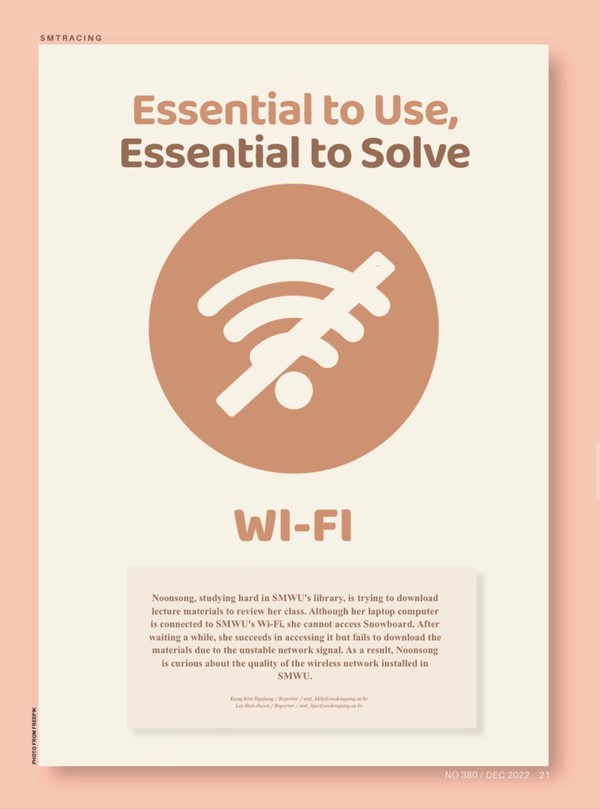
Noonsong, studying hard in SMWU's library, is trying to download lecture materials to review her class. Although her laptop computer is connected to SMWU's Wi-Fi, she cannot access Snowboard. After waiting a while, she succeeds in accessing it but fails to download the materials due to the unstable network signal. As a result, Noonsong is curious about the quality of the wireless network installed in SMWU.
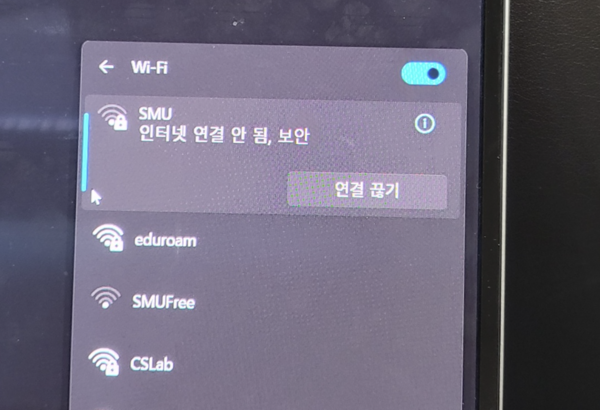
Wi-Fi not working on campus
The wireless environment at SMWU
The Wi-Fi at SMWU is closely related to students' learning. The lecture materials that students need are posted in the classes on Snowboard. Due to the weak Wi-Fi signal, it may be impossible to download them, which could interfere with class. Kim Hyuna, Department of Mechanical Systems Engineering '22, said, "It is difficult to follow practical classes such as CAD or coding when the Wi-Fi doesn't work well as lecture materials uploaded on Snowboard are needed." She stressed the importance of Wi-Fi, referring to her experience of having difficulty in following classes when network access is not running smoothly. In addition, the quality of Wi-Fi affects a large portion of students trying to participate in lectures. Currently, SMWU has some lectures that are only recorded, and sometimes Zoom classes are conducted to make up for some missed classes. So, the use of Wi-Fi is essential for students to participate, and good Wi-Fi quality is required not only for students but also for professors for smooth lectures. Also, SMWU checks attendance and uses student IDs through an app called Heyoung Campus. Therefore, wireless networks are a large part of SMWU's campus life, so many Wi-Fi routers are needed.
For this reason, the number of Wi-Fi routers installed at SMWU is 800, and 50 out of those 800 routers are installed in the SMWU library. It excludes Wi-Fi routers such as iptime used by individuals. According to the Office of Digital Infrastructure at SMWU, the iptime router which is mainly used for home or personal purposes cannot accommodate many users. Therefore, SMWU uses a Wi-Fi router with its own amplification function without iptime. Also, if the capacity in the lecture room is more than 40, additional routers are installed or separate communication design work on their own is conducted. However, students' complaints of inconvenience in using the Wi-Fi on campus have been consistently made. Go Jinkyung, Department of Entrepreneurship '22, said, "It is difficult to download lecture notes on the Internet because of the unstable Wi-Fi connection in room 511 of the Queen Sunheon Building in which more than 40 people attend lectures. Especially, the instability issue of the Wi-Fi connection is more serious in crowded places such as the central library and lecture rooms." She pointed out the limitations of Wi-Fi in places where many students gather. However, there is no clear installation standard for Wi-Fi routers. This is seen to be due to the properties of the Wi-Fi routers being sensitive to various factors such as the location, the material of the wall, and interference with other radio waves. It shows that using quality Wi-Fi is difficult for students on campus even though SMWU has tried to improve the Wi-Fi environment.
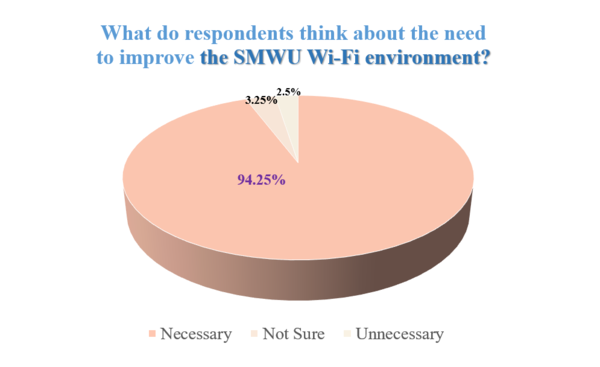
Tracking down Sookmyungians' voices
To investigate the specific purpose and satisfaction of students using the Wi-Fi on campus, SMT conducted a survey in which all 400 respondents had used SMWU's Wi-Fi, and multiple responses were possible. Of the 400 respondents, 362 (90.5%) used Wi-Fi for the purpose of the Heyoung app, followed by 359 (89.75%) who used it for data research.1) In addition, 357 (89.25%) used it to download lecture notes, 310 (77.5%) used it to watch lectures on Snowboard, and 280 (70%) used it to access real-time lectures. The responses show that more than 70% use Wi-Fi for various learning purposes. In addition, 9 out of 10 students use Wi-Fi to access the Heyoung app. Wi-Fi is seen as necessary for students because Heyoung Campus is used for purposes such as connecting mobile student IDs for entering campus or checking individual student attendance. Although Wi-Fi is multipurpose, 135 (33.75%) were completely dissatisfied with the Wi-Fi, 196 (49%) were dissatisfied, 56 (14%) were satisfied, and 13 (3.25%) were completely satisfied. More than 8 out of 10 students feel dissatisfied with the campus Wi-Fi. In this regard, 377 out of 400 (94.25%) said the Wi-Fi environment needed to be improved, followed by 13 (3.25%) who said they were not sure, and the remaining 10 (2.5%) said it was not necessary. Finally, 69 out of 400 (17.25%) said they were satisfied or very satisfied with the Wi-Fi, but only 23 out of 400 (5.75%) answered that they were not sure about the improvement of the Wi-Fi environment or that it was not necessary. It means that those who are satisfied with it have experienced inconvenience and feel the need for improvement.
Based on this survey, SMT looked into the reasons for satisfaction or dissatisfaction with the campus Wi-Fi. For satisfaction, 46 out of 69 (66.6%) mentioned the high accessibility of the Wi-Fi, 33 (47.8%) its stable connection and 17 (24.6%) the speed of the Wi-Fi. On the other hand, 313 out of 331 (94.6%) were dissatisfied with the unstable connection, followed by 272 (82.2%) who were dissatisfied with the slow speed, and 63 (19%) pointed out the low accessibility. It shows that most students have suffered from the relatively poor quality of the Wi-Fi. According to a survey of places where people experience inconvenience using the Wi-Fi on campus, the SMWU library had the largest number of mentions with 242 out of 400 (60.5%), followed by 208 (52%) at Myungshin Building, 172 (43%) at Queen Sunheon Building, and 90 (22.5%) at Veritas Building. In addition, there were 64 (16%) in Prime Complex and 40 (10%) in the College of Science. Other buildings on campus, including the Student Union Building, Sookmyung Residence Hall, and the College of Pharmacy, also presented difficulties. This reveals not only the performance problem of the Wi-Fi itself, but also the problem that students feel uncomfortable using it in specific spaces such as the SMWU library, and Myungshin, Sunheon, and Veritas buildings. Also, these are spaces frequently used by many students. It means that the Wi-Fi can't accommodate the amount of people trying to use it. Kim Kyuwon, Department of English Language & Literature '21, said, "The Wi-Fi on the second floor of the SMWU library often disconnects and its signal is unstable, so all the students become confused because the Wi-Fi of the library cuts off while they're watching a lecture on Zoom." This shows that the problem is caused by the Wi-Fi itself rather than students or defects in their personal devices. Therefore, it seems important to find the causes of these problems and solve them.
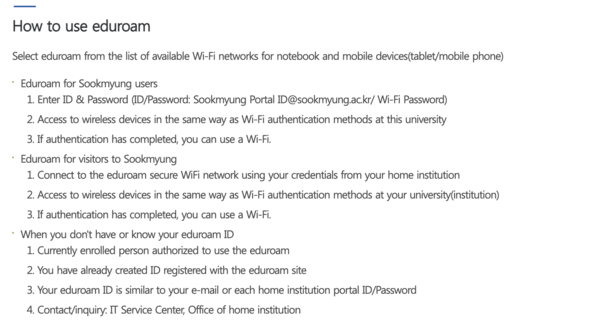
Notice about how to use Wi-Fi
Improvement to be the best
To share the opinions of students and receive answers to their questions, SMT interviewed the Office of Digital Infrastructure at SMWU. First, SMT inquired about the Wi-Fi connection, students' biggest complaint. Lim Junseok, at the Office of Digital Infrastructure, commented on the usage status and signal strength of the Wi-Fi at SMWU, saying the school is aware of the problem with the Wi-Fi signal in the lecture rooms. The reason why the Wi-Fi signal is so weak is that not only students' laptops but also tablets and smartwatches are connected to routers at the same time. This explains that even if there is only one user, the router signal may be unstable due to multiple devices connected to it. In September, to solve this problem, SMWU replaced all the routers with new ones in the College of Science. In addition, he said that SMWU will install new routers in those lecture rooms with weak Wi-Fi signals and that they are proceeding with a new design to install new routers that can accommodate various devices being connected. Also, he said it will replace about 200 routers in SMWU to improve the wireless network on campus. To supplement the routers used, SMWU plans to develop the online environment for students by installing routers with better performance. Meanwhile, students' frequent movement is cited as the reason why students feel uncomfortable with the Wi-Fi. Loss of Wi-Fi can happen due to students' frequent movement even if it is not marked as a dead zone. A dead zone is a place where Wi-Fi is not connected or the signal is weak though Wi-Fi- routers are installed. Therefore, SMWU continuously checks for dead zones and eliminates them when found. As such, SMWU is devising various methods to solve the Wi-Fi inconvenience for students.
Students are also worried about the security of the Wi-Fi on campus. Network firewalls are required for the security of the network. A network firewall is one of the components for protecting internal information and assets from external intrusion. This firewall controls access and authenticates users. SMT also asked about the Wi-Fi security status of SMWU. He said, our university's network firewall has very strong security. Internet Protocol (IP), which is not allowed, can't access our wireless network, making it more secure than Wi-Fi used in ordinary homes or cafés. Meanwhile, the survey's results showed that it is difficult to find the Wi-Fi password information. In response, he said SMWU is currently notifying about it through the school's website but admitted the difficulty of finding the notices. Then, he said he would try to use the announcements feature or Heyoung Campus notifications for students who do not know how to unlock SMWU's Wi-Fi. Finally, he mentioned the side effects of excessive additional installation of routers. It causes radio wave interference and lowers the speed when the radio wave of routers is not taken into account. He also said that, unlike wired networks, wireless networks have many variables, making it difficult to satisfy all students. Nevertheless, SMWU is striving to increase user satisfaction and build a comfortable wireless network. To establish a better online environment, it seems necessary to specifically recognize the inconvenience of students and communicate more with each other.
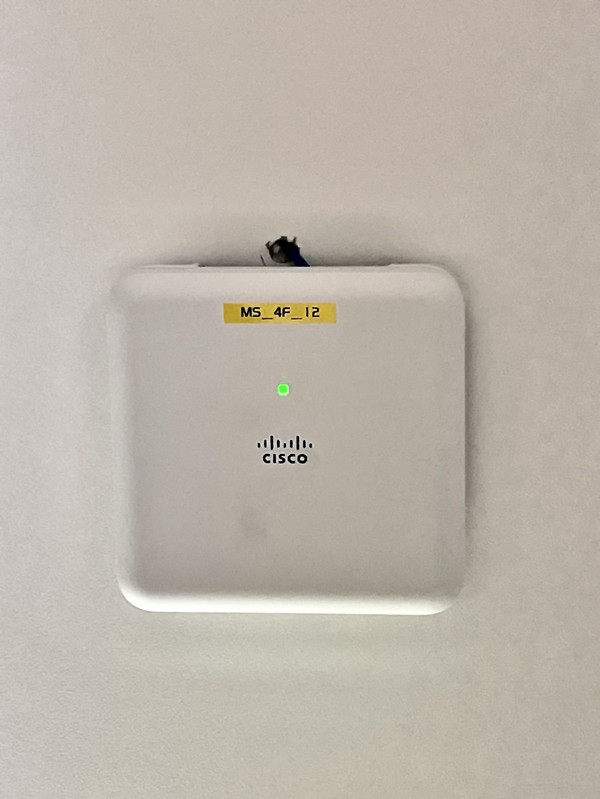
Wi-Fi router at SMWU
How to be connected everywhere at Sookmyung
Downloading lecture notes, researching, and taking classes all require the Internet through Wi-Fi, meaning it is essential for students' studies. However, many students have been complaining of inconvenience due to the Wi-Fi disconnection or instability. Accordingly, the Office of Digital Infrastructure at SMWU is trying to decrease the dead zones. Also, it has a plan to install additional routers to improve the network conditions. Therefore, students' attention is required to what will arise from the Office of Digital Infrastructure's efforts in the future.
1) The total number of students enrolled is 12,249, with a survey participation rate of about 3.3%
Kang Kim Hyojung / Reporter
smt_kkhj@sookmyung.ac.kr
Lee Han Jiwon / Reporter
smt_hjw@sookmyung.ac.kr


